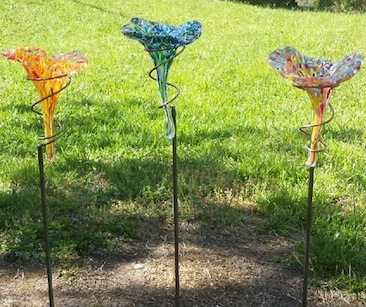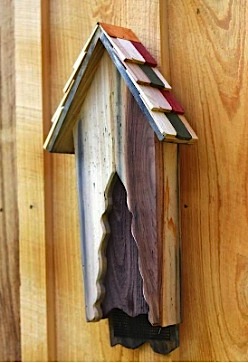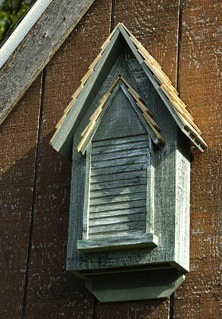-
Newest Bat Houses are Vinyl/PVC
Smart innovations (made in the USA) using durable materials means better quality, especially for items that remain outdoors. For seven years, we’ve had phenomenal feedback on all of our vinyl birdhouses and feeders – in fact some folks even thought they were made from wood!
With the popularity of natural insect control, and the increasing aversion to pesticides (thank goodness), bat houses have become a top preference for zapping those blood-sucking, nasty insects!
This brand new bat shelter with many a creature comfort will entice friendly brown bats and keep them roosting around your place. One tiny single bat can eat more than 1000 mosquitoes per night, now multiply that by 65, which is the approximate capacity here.
Made in the USA, the new vinyl design is completely impervious weather… will not crack, warp, split or mildew. The light color actually helps cool the box and stabilize inside temperatures during warm summer months. That’s important stuff if you’re a bat! It also blends well with the lighter colors of exterior paint on many homes – and that’s important stuff to people, it won’t stick out like a sore thumb!
Mounting height should be at least 15 ft. from the ground, on any structure, tree, or 4×4 post. Be sure entry is free and clear of any limbs or branches which might impede landing. It may take a little time for bats to discover their new digs, but if they already reside in your area, occupancy could be immediate. Having water nearby is more appealing to them; as in a creek, lake, stream or pond. Not a requirement, but more suitable habitat.
So vow to quit the bug zappers and chemicals this year, it’s far better for everyone’s health and the environment too. Try a bat house and entice these friendly, furry little mammals to your yard!
-
Naturally Man Made Butterfly Feeders, huh?
A few, yes there were actually three or four butterflies spotted in the yard last month. Because winter dragged it’s sorry butt into spring again this year, there really wasn’t anything blooming yet from where butterflies could draw nectar. Offering leaf misters through summer (which butterflies love), we’re really not ones to offer butterfly feeders, because there’s enough to maintain in our wildlife habitat already!
Quick… run to the store for plants in bloom so the flying gems might have something to eat and decide to stick around! This hibiscus did nicely, as well as this orange tube thing
… I couldn’t tell you the name, but most tube-shape flowers are nectar producers (good to know).
Enter a local artisan and glass blower spotted at a craft show. Hhmmm? Can you make us some glass flowers and put them on a tall stake? We want to use them in the garden as butterfly feeders! After a few weeks and some back & forth… ta-dah!
Some of the most beautiful staked glass butterfly feeders we’d ever seen, they came out awesome! The pics don’t really do them any justice, because sunlight accents the colors and makes them sparkle.
On a 36-inch stake, they’re perfect anywhere in the garden, and are quite versatile for birds too.
Complete with a piece of sea sponge which acts like a wick, butterflies can draw nectar naturally as they do from flowers. Fill it with water as a sipper for any songbird, or a few spoonfuls of grape jelly for orioles, cat birds and other migratory birds. You can even do suet chunks or seed in winter for your resident fliers.
Hand-blown glass and locally made ensure these feeders are unique and high quality, and we can promise if the habitat is right, both butterflies and birds will be winging their way right to them!
-
Attract Them and Offer Roosts with Bat Houses
They make some cool shelters these days, from vintage to Victorian, recycled plastic, even kits to build your own bat houses. You can try your luck at attracting bats without a big investment. But why would anyone want to attract them? One word – beneficial would sum it up best!
Bats are major pollinators and seed spreaders. Natural insect control is another huge advantage to hosting these friendly mammals (yes, they’re mammals). Even small bat colonies will consume thousands of mosquitoes and other pests nightly.
Habitat plays a key role in attracting any friendly fliers to your place. This holds true for butterflies, hummingbirds and songbirds too. If pesticides are being used, stop! They’re harmful to the to the environment, wildlife and the ecosystem in general. Pristine, manicured lawns are becoming passe, more naturalized areas are in style. This doesn’t mean jungle… it involves use of native plants, naturalized beds, and varied habitat.
You can attract bats by offering places for them to roost (other than your attic vents). Bat houses needn’t be plain square boxes, but stylish shelters that complement the landscape. The two shown are handcrafted in the USA, and made from solid cypress.
If water exists on your property, there’s a strong likelihood bats will use your shelters. Being near a creek, stream, or pond is preferable. They require a stable environment, steady temperatures within their roosts. Facing the houses south will allow full sun exposure to warm the boxes. Two bat houses are even better, facing them in different directions and allowing for varying temperatures. Leaving an outside light on at night may also assist in bringing bats to your place. As bugs swarm the light, bats will follow if they’re currently near your property.
Height is important when installing the houses as well. Some say 10 feet is sufficient, others claim 15-20 feet from the ground is best. Mount directly on a tree, structure or pole.
You can learn more about housing specs and hosting bats from The Organization for Bat Conservation.

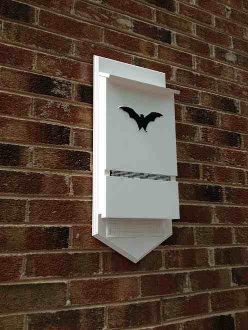
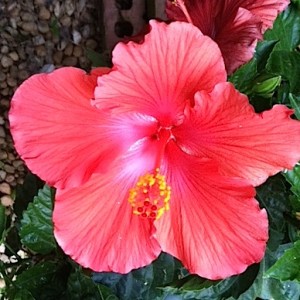
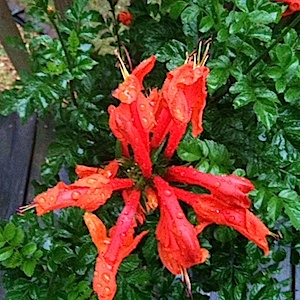 … I couldn’t tell you the name, but most tube-shape flowers are nectar producers (good to know).
… I couldn’t tell you the name, but most tube-shape flowers are nectar producers (good to know).